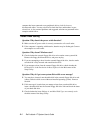
Troubleshooting
B-1
APPENDIX B
Troubleshooting
This chapter describes how to troubleshoot computer problems.
Common Problems
Problems with your computer can be caused by something as minor as an
unplugged power cord or as major as a damaged hard disk drive. The information
in this troubleshooting section is designed to help you find and solve minor
problems. If you still have a problem after trying all the suggested remedies in this
chapter, contact your service representative.
The problems that you might encounter can be divided into two basic categories:
hardware and software. Hardware problems can be further divided into being of an
electrical or a mechanical nature. You will know you have a hardware problem if,
for example, the screen is blank, or the computer cannot recognize the disk drives.
Software problems can occur at several levels. Both your operating system and your
software application programs are capable of generating errors and error messages.
If you encounter a software error, try to determine if the error message is from your
operating system or from an application program, and refer to the appropriate
manual for possible remedies.
You can also refer to the operating system manual or Windows Help program to
solve the problem. To access the Help program, select Help from the Start menu. It
also gives you Troubleshooting tips and an Index.
Successful troubleshooting is the result of careful observation, deductive reasoning,
and an organized approach to solving the problem. If you encounter a problem,
begin by performing a careful visual inspection. Check the exterior of the computer
first. If no lights are displayed, check the battery charge or power outlet, the plug
and power cord, and any power switches that may affect your computer. If the


















